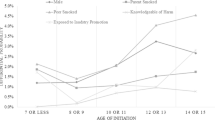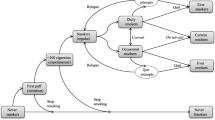Abstract
Background: To examine if the recommended taxonomies for the stages of youth smoking onset are aligned with the beliefs of smoking youth.
Methods: The SHAPES Tobacco Module was administered to 23,047 students (grades 9 to 13) in a convenience sample of 29 secondary schools during the 2000–2001 school year in the province of Ontario, Canada. Cross-tabs were used to compare a student’s selfperceived smoking status to their smoking status as determined with the currently recommended stage taxonomies for smoking behaviour.
Results: The majority of students classified as regular smokers (52.4%) and experimental smokers (98.9%) did not actually consider themselves to be smokers. Self-reported smoking status appeared to be relatively consistent for the never smoker and established smoker categories.
Conclusions: Additional research is required to develop stage taxonomies that are aligned with the self-perceptions of non-established youth smokers.
Résumé
Contexte: Déterminer si la taxonomie recommandée des étapes menant à la décision de fumer chez les jeunes correspond aux perceptions des jeunes fumeurs.
Méthode: Le module sur le tabagisme du système SHAPES (School Health Action Planning and Evaluation System) a été administré à 23 047 élèves (de la 9e à la 13e année) d’un échantillon de commodité de 29 écoles secondaires pendant l’année scolaire 2000–2001 dans la province de l’Ontario. Par croisement des données, nous avons comparé l’usage du tabac perçu par l’élève et l’étape où en est cet élève selon la taxonomie actuellement recommandée de l’usage du tabac.
Résultats: Une majorité d’élèves se classait dans la catégorie des fumeurs réguliers (52,4 %), mais les fumeurs à titre expérimental (98,9 %) ne se considéraient pas vraiment comme étant des fumeurs. L’usage du tabac déclaré par l’intéressé correspondait assez bien à la taxonomie recommandée dans la catégorie des personnes n’ayant jamais fumé et dans celle des fumeurs permanents.
Conclusions: Il faudrait pousser la recherche pour élaborer une taxonomie qui corresponde aux autoperceptions des jeunes fumeurs qui ne fument pas encore régulièrement.
Similar content being viewed by others
References
Mayhew KP, Flay BR, Mott JA. Stages in the development of adolescent smoking. Drug Alcohol Depend 2000;59:S61–S81.
Rubinstein ML, Halpner-Felsher BL, Thompson PJ, Millstein SG. Adolescents discriminate between types of smokers and related risks: Evidence from nonsmokers. J Adolesc Res 2003;18:651–63.
Nichter MI, Nichter MA, Vuckovic N, Quintero G, Ritenbaugh C. Smoking experimentation and initiation among adolescent girls: Qualitative and quantitative findings. Tob Control 1997;6:285–95.
Dugan S, Lloyd B, Lucas K. Stress and coping as determinants of adolescent smoking behavior. J Appl Soc Psychol 1999;29:870–88.
Sargent JD, Mott LA, Stevens M. Predictors of smoking cessation in adolescents. Arch Pediatr Adolesc Med 1998;152:388–93.
Leatherdale S, McDonald PW. What smoking cessation approaches will young smokers use? Addict Behav 2005;30:1614–18.
Leatherdale S, Brown S, Cameron R, McDonald PW. Social modelling in the school environment, student characteristics, and smoking susceptibility: A multi-level analysis. J Adolesc Health 2005;37:330–36.
Stanton WR, McClelland M, Elwood C, Ferry D, Silva PA. Prevalence, reliability and bias of adolescents’ reports of smoking and quitting. Addiction 1996;91:1705–14.
O’Loughlin J, DiFranza J, Tindale RF, Meshefedjian G, McMillan-Davey F, Clarke PB, et al. Nicotine-dependence symptoms are associated with smoking frequency in adolescents. Am J Prev Med 2003;25:219–25.
Author information
Authors and Affiliations
Corresponding author
Rights and permissions
About this article
Cite this article
Leatherdale, S.T., McDonald, P.W. Are the Recommended Taxonomies for the Stages of Youth Smoking Onset Consistent with Youth’s Perceptions of Their Smoking Status?. Can J Public Health 97, 316–319 (2006). https://doi.org/10.1007/BF03405612
Received:
Accepted:
Published:
Issue Date:
DOI: https://doi.org/10.1007/BF03405612




